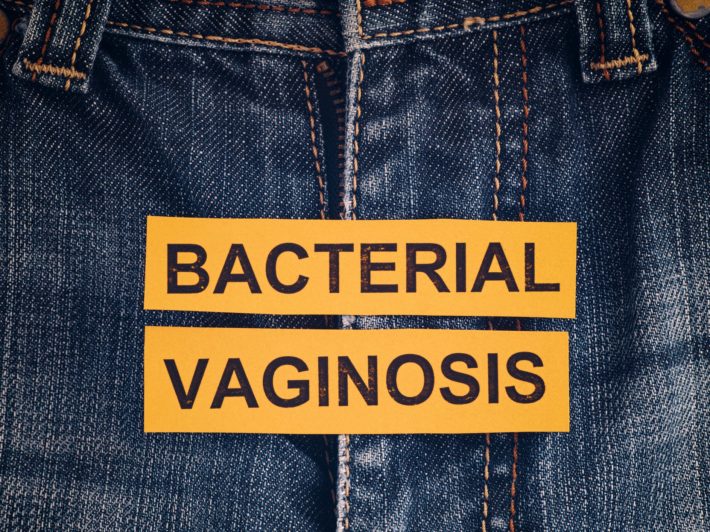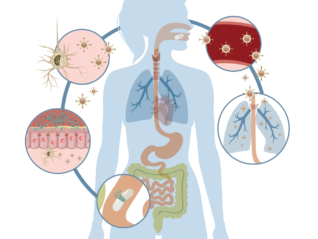
Angela Kelly, MA and Michael Stanclift, ND
In part one of this three-part series, we’ll discuss a healthy vaginal microbiome, symptoms, and the diagnostic criteria of bacterial vaginosis (BV).
A healthy vaginal microbiome
The vaginal microbiome is the lesser-known heroine of the body’s microbiomes and the first line of defense against pathogens that can cause infections.1-5 Like the gut microbiome, the vaginal microbiome is seeded from mother to daughter and the surrounding environment within 24 hours of birth.6-7Hormonal fluctuations related to puberty, the menstrual cycle, pregnancy, and menopause each contribute to the constantly changing landscape of the vaginal microbiome.8
During the reproductive years, the vaginal vault is populated by 90–95% lactobacilli in a balanced, healthy state. 9-10 Vaginal epithelial cells deposit glycogen, and the “friendly” lactobacilli ferment the polysaccharide, producing lactic acid.11 This fermentation process serves to lower vaginal pH, inhibit potentially harmful anaerobes’ growth, and discourage pathogens’ attachment to the vaginal epithelium.11 Additionally, lactobacilli produce antimicrobials such as hydrogen peroxide and bacteriocins, which deter biofilms and keep pathogenic anaerobes dormant.11 But what happens when the bacterial balance of the vagina is thrown out of whack?
Bacterial vaginosis characteristics
Bacterial vaginosis (BV) is the often silent, sometimes maddening, and quite common vaginal microbiome dysbiosis that affects 29.2% of women of reproductive age in the United States.12 The dysbiosis of BV is characterized by decreased “friendly” lactobacilli and an overgrowth of potentially pathogenic bacteria that may multiply to 1,000-10,000 times normal levels.13 Many studies suggest asymptomatic BV poses serious threats to reproductive and urogenital health and increases the risk of contracting and transmitting STIs.9,14-15 While the exact cause of BV is still under debate, the initial disruption of the vaginal microbiome is likely due to sexual transmission.16-17 Although with significantly lower frequency, females who have never been sexually active can also develop BV.18
BV is found globally, with higher incidences in certain countries and ethnicities.9 In the United States, Black and Mexican-American women are more likely to be affected by BV.9,19-20 Despite being the most common vaginal dysbiosis, women’s awareness of BV prior to their first infection is very low.21
Symptoms of bacterial vaginosis and diagnostic criteria
While most BV cases occur asymptomatically, the CDC describes the following common symptoms that may occur:12,22
- A thin white or gray vaginal discharge
- Pain, itching, or burning in the vagina
- A strong fish-like odor, especially after sex
- Burning when peeing
- Itching around the outside of the vagina
BV can be diagnosed using Amsel’s criteria or the Nugent scoring system.
Amsel’s criteria for the diagnosis of BV are met when 3 out of 4 of the following clinical signs are present:23
- Abnormal vaginal discharge
- Amine (fish-like) odor when vaginal fluid is exposed to 10% potassium hydroxide (KOH)
- Clue cells on wet mount
- Vaginal pH > 4.5
Alternatively, the Nugent scoring system can be used to diagnose BV using a Gram stain, microscope, and a 0-10 score based on the amounts of the following microorganisms seen per high-powered field:24
- Curved rods (Mobiluncus species morphotypes)
- Gram variable rods (Garderella vaginalis morphotypes)
- Lactobacillus morphotypes
So now that we have some of the basic background knowledge of the vaginal microbiome and how to detect BV in our patients, part two of this series will look at causes and risk factors, health impacts, and current conventional therapies for BV. In part three, we’ll look at alternative and emerging treatments, the role of probiotics, and discuss the mechanisms behind these approaches.
Citations
- Brotman RM. Vaginal microbiome and sexually transmitted infections: An epidemiologic perspective. J Clin Invest. 2011;121(12):4610-4617.
- Graver MA et al. The role of acidification in the inhibition of Neisseria gonorrhoeae by vaginal lactobacilli during anaerobic growth. Ann Clin Micro Antimicrob. 2011;10(1):8-8.
- O’Hanlon DE et al. In vaginal fluid, bacteria associated with bacterial vaginosis can be suppressed with lactic acid but not hydrogen peroxide. BMC Inf Dis. 2011;11(1):200.
- Gong Z et al. Lactobacilli inactivate Chlamydia trachomatis through lactic acid but not H2O2. PloS One. 2014;9(9):e107758-e107758.
- Nunn KL et al. Enhanced trapping of HIV-1 by human cervicovaginal mucus is associated with Lactobacillus crispatus-dominant microbiota. MBio. 2015;6(5):1-9.
- Rotimi VO et al. The development of the bacterial flora in normal neonates. J Med Microbiol. 1981;14:51-62.
- Borges S et al. The role of lactobacilli and probiotics in maintaining vaginal health. Arch Gynecol Obstet. 2014;289(3):479–895.
- Joseph RJ et al. Finding a balance in the vaginal microbiome: how do we treat and prevent the occurrence of bacterial vaginosis? Antibiotics (Basel). 2021;10(6):719.
- Coudray MS et al. Bacterial vaginosis-a brief synopsis of the literature. Eur J Obstet Gynecol Reprod Biol. 2020;245:143-148.
- Bautista CT et al. Association of bacterial vaginosis with chlamydia and gonorrhea among women in the U.S. army. Am J Prev Med. 2017;52(5):632-639.
- Amabebe E et al. The vaginal microenvironment: the physiologic role of lactobacilli. Front Med (Lausanne). 2018;5:181.
- Koumans EH et al. The prevalence of bacterial vaginosis in the United States, 2001-2004; associations with symptoms, sexual behaviors, and reproductive health. Sex Transm Dis. 2007;34(11):864-869.
- Larsson PG et al. Diagnosis of bacterial vaginosis: need for validation of microscopic image area used for scoring bacterial morphotypes. Sex Transm Infect. 2004;80(1):63-67.
- McKinnon et al. The evolving facets of bacterial vaginosis: implications for HIV transmission. AIDS Res Hum Retrovir. 2019;35(3):219-228.
- Allsworth JE et al. Severity of bacterial vaginosis and the risk of sexually transmitted infection. Am J Obstet Gynecol. 2011;205(2):113.e1-113.e1136.
- Zozaya M et al. Bacterial communities in penile skin, male urethra, and vaginas of heterosexual couples with and without bacterial vaginosis. Microbiome. 2016;4(16):16.
- Liu CM et al. Penile microbiota and female partner bacterial vaginosis in Rakai, Uganda. 2015;6:e00589.
- Yen S et al. Bacterial vaginosis in sexually experienced and non-sexually experienced young women entering the military. Obstet Gynecol. 2003;102:927–933.
- Ness S et al. Can known risk factors explain racial differences in the occurrence of bacterial vaginosis? J Natl Med Assoc. 2003;95:201-212.
- https://www.cdc.gov/std/bv/stats.htm. Accessed September 19, 2022.
- Bilardi J et al. Women’s management of recurrent bacterial vaginosis and experiences of clinical care: a qualitative study. PLoS One. 2016;11(3):
- https://www.cdc.gov/std/bv/stdfact-bacterial-vaginosis.htm. Accessed September 19, 2022.
- Amsel R et al. Nonspecific vaginitis. Diagnostic criteria and microbial and epidemiological associations. Am J Med. 1983;74:14-22.
- Udayalaxmi J et al. Comparison of the methods of diagnosis of bacterial vaginosis. J Clin Diag Res. 2011;5(3):498–501.
Angela Kelly, MA holds a master’s degree in Communication Management and Marketing from the University of Southern California and is a writer at Metagenics. She enjoys deep-dive research projects and sharing information with patients and practitioners. You will find her with her husband and three children on a sports field or at the beach when she’s not writing.
Michael Stanclift, ND graduated from Bastyr University’s school of naturopathic medicine and practiced in Edinburgh, Scotland, and Southern California. He enjoys educating other healthcare providers and impacting the lives of their many patients. When he’s not working, he spends his hours with his wife and two children.





